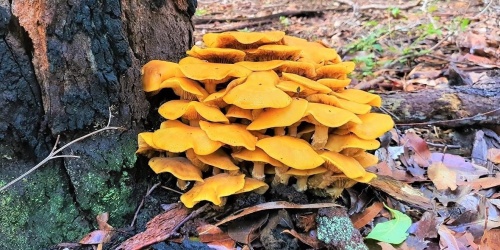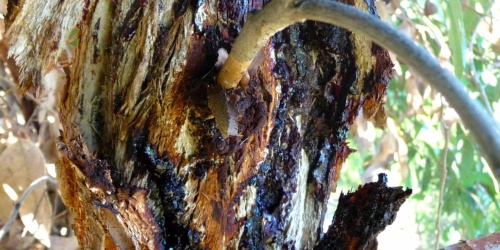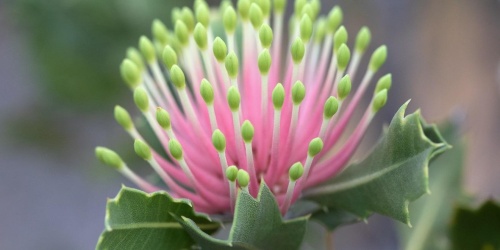
Myrtle rust yellow spores on Geraldton wax flowers. Photo by Geoff Pegg
Myrtle rust is a serious disease that infects and kills many plants belonging to the Myrtaceae family including eucalypts, bottlebrushes, paperbarks and peppermint trees.
This fungus was found in Australia for the first time in 2010 and it was detected on an isolated property in northern Western Australia in June 2022. We are working with the Department of Primary Industries and Regional Development (DPIRD) to monitor myrtle rust in Western Australia.
What is myrtle rust?
Myrtle rust is a serious plant disease from South America caused by a rust fungus called Austropuccinia psidii, which spreads via wind-borne spores. Myrtle rust affects plant species in the Myrtaceae family.
The bright yellow (rarely yellow-orange) masses of spores are a distinguishing feature of myrtle rust. Myrtle rust attacks actively growing shoots, stems and other soft young tissues such as fruits, flowers and emerging seedlings.
This fungal pathogen of the Myrtaceae family (which includes iconic native plants such as Geraldton wax, bottlebrush and eucalyptus) originated in South America and was first detected on the east coast of Australia in 2010.
How will myrtle rust impact Western Australia?
Myrtle rust attacks plants from the Myrtaceae family and Western Australia is home to over 1,800 native myrtaceous taxa. We know that at least some of our native myrtaceous plant species are extremely susceptible to myrtle rust from glasshouse trials in the eastern states and observations of the impact of the pathogen on Western Australia species that are grown as ornamentals in the eastern states. The Myrtaceae family contains many iconic and ecologically important species including:
- eucalypts and paperbarks;
- bottlebrushes;
- Geraldton wax; and
- Western Australia peppermint trees, to name just a few.
Myrtle rust can also affect industries including nursery, forestry, cut flower and apiary. Attempts to eradicate myrtle rust in the eastern states were unsuccessful.
How to prevent the spread of myrtle rust
Quarantine - don’t bring Myrtaceae plants into Western Australia.
Hygiene - ensure all equipment, clothing and personal items are clean before re-entering Western Australia from the eastern states or overseas.
Surveillance – learn how to recognise myrtle rust, keep an eye out for it and report it immediately if you think you see it. Western Australia bush walkers and travellers to northern Western Australia are encouraged to look and report signs of myrtle rust.
How to recognise myrtle rust
Early signs - look for raised spots which are brown-grey with red-purple haloes. In the next two weeks, yellow spores will begin to appear. Look for infection on the softer underside of leaves, as well as shoot tips, fruits, flowers and new growth.

What to do if you spot myrtle rust
If you think you have spotted myrtle rust:
- Do not take a sample or touch it because spores can be easily spread.
- Immediately report your sighting using the MyPestGuideTM app or website (mypestguide.agric.wa.gov.au) or contact the DPIRD Pest and Disease Information Service on 9368 3080 or padis@dpird.wa.gov.au.
- Record what you see (what the infection looks like, the extent of the infection, how many plants are infected etc.). If you know the species of plant infected, record that as well.
- Take photos of the symptoms and the plant, and precise details about the location (GPS ideal) to provide with your report.
If you suspect your belongings have been contaminated with myrtle rust spores, leave them at the site or contain them until you are able to wash them.
Early detection and reporting may reduce the long-term impact of myrtle rust in Western Australia!
Photos and location information can additionally be submitted via the DPIRD MyPestGuide Reporter app.

Further resources
- Department of Primary Industries and Regional Development (WA) - Myrtle rust threat
- Department of Agriculture, Water and the Environment (Fed) - Myrtle rust (Austropuccinia psidii)
- Invasive Species Council - Myrtle rust
- Myrtle rust National Action Plan
- Myrtle rust article - Bushland News Summer 2020-2021


